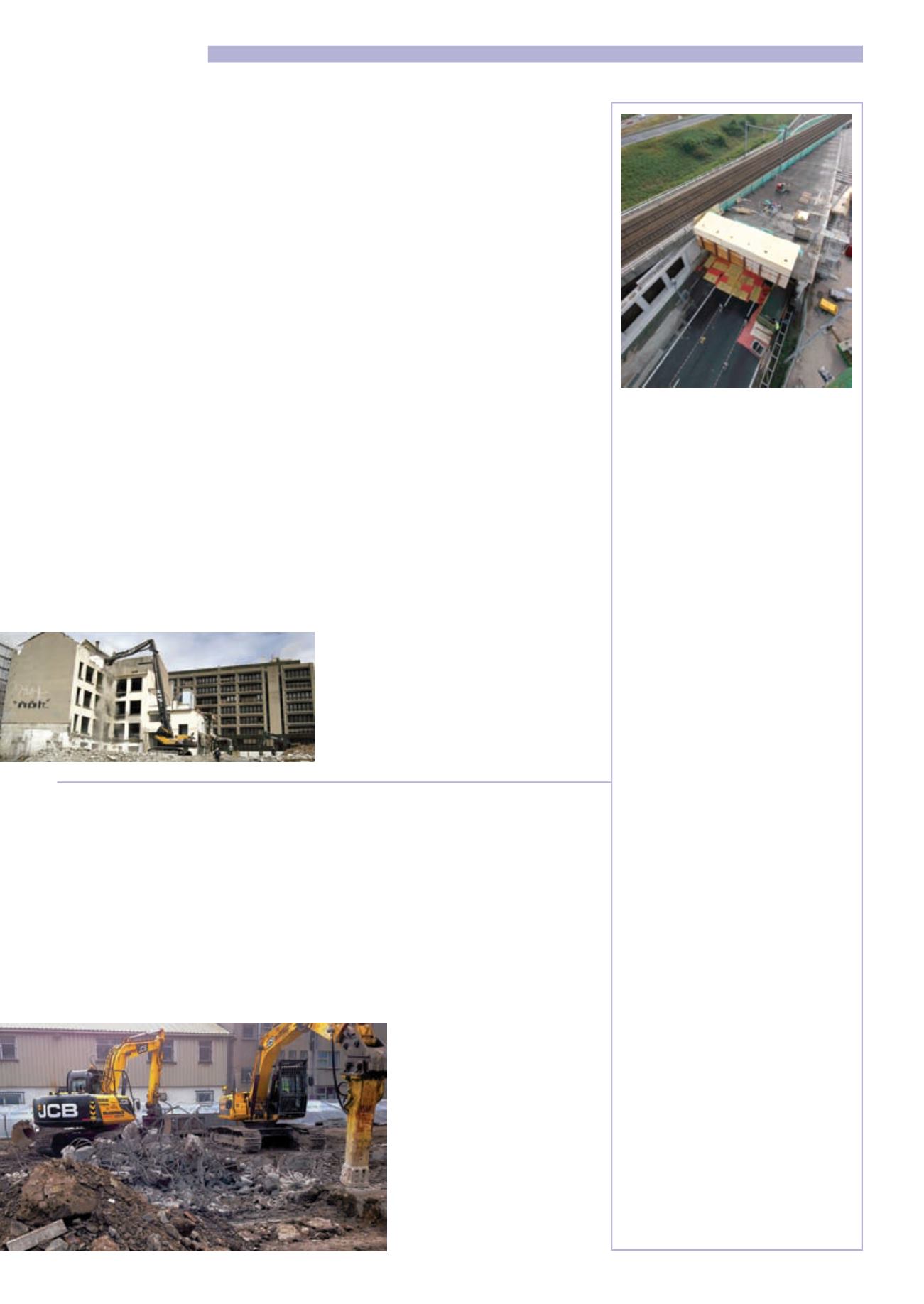
40
CONSTRUCTION EUROPE
DECEMBER 2013-JANUARY 2014
DEMOLITION
ADS used two Aquajet Systems Aqua
Cutter 710V evolution robots for the
Amsterdam project
Hydrodemolition
saving time
Existing elevated rail decking in the
Netherlands
presented
demolition
problems for the contractor BAM Civiel
in making ready for joining it to a newly-
constructed concrete deck and new twin-
rail track.
However, hydrodemolition specialist
Aqua Demolition Services (ADS) said it
was able to solve this when exposing the
steel cables to allow inspection before
connecting the new elevated concrete
deck and rail tracks in Amsterdam.
Fabricated some 20 years ago in
readiness for future expansion, the old
reinforced concrete deck – above the
busy A10 highway through the southern
suburbs of south Amsterdam – included
two post-tensioned cables.
After removing a balustrade/end wall
at one end of the old deck, using a
conventional concrete wire saw, it was
necessary to remove the deck concrete to
expose the rebar for reinstalling to the new
adjoining deck.
However, a bigger problemwas exposing
the post-tensioned cables for inspection
and recasing in new concrete, without any
damage whatsoever to the steel cables
and rebar.
ADS provided the solution with
hydrodemolition
techniques
using
two Aquajet Systems Aqua Cutter 710V
evolution robots.
ADS director Arjan de Waard said,
“Without using the Aqua Cutters, possibly
the only other solution would have been
to use hand lances – taking eight to ten
operators at least two weeks to clear all the
specified concrete safely.
“Using
Aquajet’s
hydrodemolition
techniques allowed us to complete the
job inside one and a half days including
set up times.”
Road traffic challenge
Tramlines, pedestrian pathways and a busy road
contributed to the problems for a Swiss project
T
he key challenges for a recent
demolition project in a main street in
Geneva, Switzerland, were a tramline,
pedestrian pathways and road traffic.
Construction and demolition company
HTP was contracted to demolish former
governmental offices at the front of the busy
Rue du Stand.
The demolition was set to create about
2,000m
3
of material, with some 900m
3
of this
to be crushed on site and reused for site
preparation and construction of the new
building. The remainder had to be taken away
for recycling, with only a small percentage
going to waste.
The Volvo EC480HR D-Series claims to be
unusual in the high reach demolition sector
as it is Stage IIIB compliant, meeting the
emissions requirements without having to be
fitted with an additional exhaust gas filtration
system.
Volvo said that HTP had ordered the high
reachmachine before even seeing the finished
product.
Yves Huguenin, founder and managing
director of HTP, said, “When we made the
decision to invest in the Volvo EC480D HR, it
didn’t actually exist. The engine was new in
terms of emissions, and the hydraulics had
been optimised, so we felt it was a good
machine for us and the right size.
“Now we have the machine on site, and I am
delighted with our decision.”
Noise restrictions mean HTP can only work
from 7am to 7pm with a one-hour shutdown
from 12pm to 1pm – but this is said to be less
of an issue with the Volvo high reach unit,
which is quieter than breaker machines.
Thierry Truffat, site manager for HTP, said,
“There is a protective screen for the operator
along the front of the four-storey building, but
this is only for small fragments and dust and
certainly wouldn’t keep out any large-scale
debris.
“This is a highly-controlled demolition
process, which requires precision and great
care. The machine enables us to conduct a
safe deconstruction with real efficiency and
high productivity.”
HTP began by taking out the windows,
electrical cabling and insulation. During this
phase it also had to deal with some asbestos
contamination, which required special
attention.
Volvo said that thanks to the high reach
machine, the team was able to made up for
lost time.
ce
One of Northern Ireland’s leading demolition
contractors has been using a fleet of JCB
demolition excavators at a high-profile Belfast
project.
McCormack Demolition is currently using
JCB models at the new University of Ulster
Belfast Campus development – a £250m (€299
million) project at York Street adjacent to and
opposite the existing Belfast campus building.
The dismantling of existing buildings will
JCBs for university project
pave the way for approximately 76,500m
2
of new university space, and 6,500m
2
of
refurbished space to be constructed.
The McCormack fleet includes five JCB
models, with a JS360XD, JS330HRD and two
JS220 models recently joined by a new JCB
JS290XD.
Said to be tailormade for demolition, each
of the XD (Extra Duty) machines features a
strengthened boom and dipper, side and
rear impact protection, rugged
undercarriage
guards
and
plating, side rail protection
systems and FOPS cab guards.
McCormack director Eamonn
McCormack said, “We have
operated JCB excavators for over
20 years now, and the XD models
come ready for work. The new
models are super machines and
provide a robust solution.
“Our fleet of different sized JCBs
means we can match the right
machine to the requirements of
each job on site.”
ce


